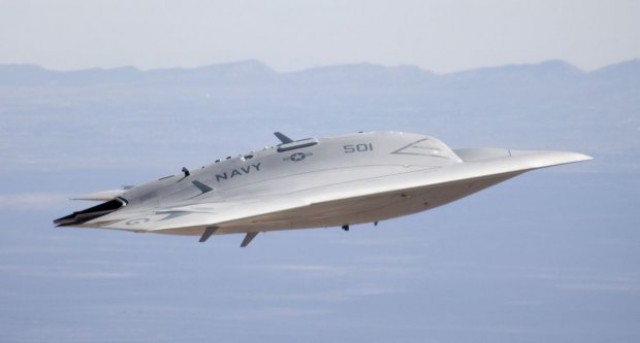The airframes expected to carry the Next Generation Jammer (NGJ) are conventional-signature unmanned aircraft systems and will be followed by stealthy unmanned designs.
NGJ is one of the U.S. Navy’s prized new programmes. To maintain its fiscal and technological attractiveness, acquisition officials are revealing some interesting revisions of the service’s airborne electronic attack (AEA) concept to ensure that NGJ will be flexible enough to be used by large numbers of different platforms.
A new logo for the office swaps the electronic surveillance “Old Crow” for a patch that features the EA-6B Prowler, EA-18G Growler and an unmanned aircraft that looks suspiciously like the Navy’s Unmanned Carrier-Launched Airborne Surveillance and Strike (Uclass) aircraft.
“That should speak volumes to you,” says Navy Capt. John Green, chief of the AEA and EA-6B Prowler programme office. “We believe that the Prowler is the [electronic warfare] past; the Growler is EW now, and the future of EW will be unmanned vehicles.”
The aerospace industry is reaching similar conclusions. Senior officials see systems-of-systems evolving with decoys and nonkinetic weapons being released by larger platforms.
Service planners say they must have an AEA system that can be “transportable” from platform to platform in order to support an advanced electronic attack capability.
“There is the potential to combine radar, electronic warfare and other capabilities for use in smaller aircraft,” says Green. “It could very well be a UAV because the Growler has a limited lifespan.”
Aerospace officials also anticipate the need for small, stealthy platforms with powerful electronic payloads.
“As platforms become smaller in the attempt to get stealthier, I see EW systems evolving into the other systems on the aircraft, because you can’t afford the weight and processing for each of the separate technologies,” Kula says.
Meanwhile the NGJ programme will be growing as it works through a series of developmental blocks involving the fielding of separate pods sequentially that operate in mid-, low- and high-frequency bands.
Advanced, long-range, air defense radars with active, electronically scanned arrays (AESAs) with double or triple the range to detect aircraft and missiles “are the kinds of technologies that really scream out and require us to take this NGJ step,” Green says. “It is the proliferation of solid-state equipment, advanced control mechanisms, sophisticated waveforms, enhanced electronic agility and electronic, counter-counter measures on the radars themselves that really push us to make these kinds of investments before the electronic attack technologies of today become obsolete.”
Most of these problems have physics at their root. Flying into heavily defended areas requires smaller, stealthier platforms. That, in turn, drives the need for electronics and power in a small, light, powerful package. While researchers have made significant advances in improving effective radiated power output, it is not yet enough. One benefit of adapting AESA radar technology to AEA, for example, is that it permits the design of small packages to focus power into tailored waveforms.
“What’s driving the current NGJ programme is the level of maturity needed to meet the initial operational dates the Navy wants,” says Nick Uros, Raytheon vice president for NGJ. “I think you can extrapolate from that they want to stick with tried and proven AESAs that are open and scalable.” This would indicate that the introduction of conformal or embedded arrays is still well into the future.
Higher up the power scale, using AESA-generated electronic beams as directed energy will likely be the dividing line between manned and unmanned AEA platforms.
“I don’t see us using the NGJ system in a directed-energy form, if for no other reason than the long standoff distances we have to operate from,” Green says. “For that mission area, you are more likely to see us put that mission onto an unmanned platform. The risk you run with putting a man well inside the kill range for an advanced surface-to-air missile is not acceptable.”
The Navy is actively exploring NGJ technology transfer to its UAV programs. That is at the heart of a decision by the chief of naval operations to move NGJ and other EW systems under a combined intelligence and command-and-control directorate to speed the fusion of EW and unmanned craft.
The Navy and Marine Corps are looking at putting NGJ on both stealthy and nonstealthy platforms. The capability is definitely going on regular-signature UAVs (such as Shadow), and researchers are studying a mission set for stealth designs (such as Uclass).
In an era of dwindling resources, the Pentagon is looking hard at the nonkinetic effects produced by electronic attack.
“It can be an economical way to either put off full-scale warfare or enhance it,” Green says. “I’m sure that creating kinetic effects by nonkinetic means is being looked at—anything to deny, degrade and deceive in the electromagnetic spectrum. You are going to see technologies shared between EW and [directed energy] are similar, but you are going to see them led by different teams because the concepts of operations are very different.”
Source: Aviation Week

